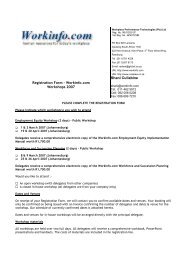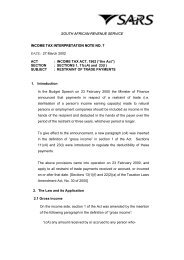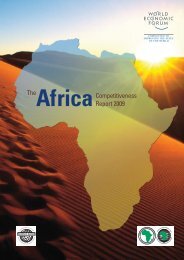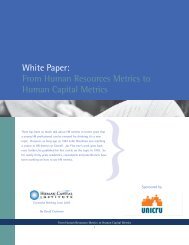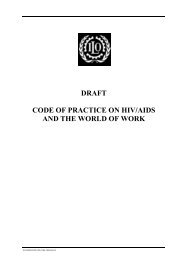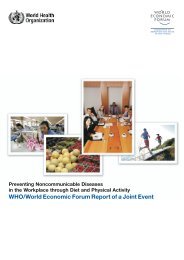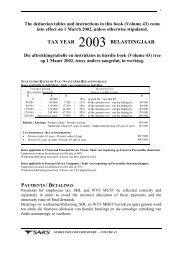The CEO's role in talent management - DDI
The CEO's role in talent management - DDI
The CEO's role in talent management - DDI
Create successful ePaper yourself
Turn your PDF publications into a flip-book with our unique Google optimized e-Paper software.
PROFILES<br />
<strong>The</strong> CEO’s <strong>role</strong> <strong>in</strong> <strong>talent</strong> <strong>management</strong><br />
How top executives from ten countries are nurtur<strong>in</strong>g the leaders of tomorrow<br />
Executive: Mart<strong>in</strong> Beaumont<br />
Title: Chief Executive Officer<br />
Company: Co-operative Group<br />
Location: Manchester, UK<br />
CEO s<strong>in</strong>ce: 2002<br />
Age: 58<br />
Previous position: CEO of United Co-op (the UK’s<br />
largest co-operative society)<br />
Sector: Conglomerate with varied hold<strong>in</strong>gs<br />
Revenue (2005): US$13.2bn<br />
Mart<strong>in</strong> Beaumont sees himself as the pivotal<br />
figure <strong>in</strong> <strong>talent</strong> <strong>management</strong> at the Co-operative<br />
Group. <strong>The</strong> CEO says his attitude to recruit<strong>in</strong>g<br />
and develop<strong>in</strong>g employees shapes attitudes at<br />
the UK conglomerate. “<strong>The</strong> visibility and the <strong>role</strong><br />
model that I present as chief executive is<br />
absolutely critical to the behaviour that we wish<br />
people to adhere to and <strong>in</strong> people recognis<strong>in</strong>g<br />
the importance I attach to develop<strong>in</strong>g our <strong>talent</strong>s<br />
and us<strong>in</strong>g all our resources to their full potential.<br />
<strong>The</strong> leadership led by myself is demonstrat<strong>in</strong>g<br />
how we expect others to manage and lead.”<br />
When Mr Beaumont became CEO <strong>in</strong> 2002,<br />
the company lacked a thorough, cohesive<br />
“Fundamentally rais<strong>in</strong>g the capability of the<br />
organisation has to have a significant<br />
f<strong>in</strong>ancial return that would greatly outweigh<br />
any cost of <strong>in</strong>vestment.”<br />
approach to <strong>talent</strong> <strong>management</strong>. <strong>The</strong>re were a<br />
few development programmes. <strong>The</strong> firm<br />
encouraged some executives to purse MBAs.<br />
“But it [<strong>talent</strong> <strong>management</strong>] was of a more ad<br />
hoc nature,” he says. “It wasn’t all jo<strong>in</strong>ed up.”<br />
Mr Beaumont saw <strong>talent</strong> <strong>management</strong>,<br />
particularly at senior levels, as vital <strong>in</strong> mak<strong>in</strong>g<br />
sweep<strong>in</strong>g changes at the Co-op. <strong>The</strong>se changes<br />
would <strong>in</strong>crease brand recognition and spur<br />
stronger, long-term growth. He felt that the<br />
company relied too much on recruit<strong>in</strong>g to fill its<br />
senior <strong>management</strong> ranks. About four <strong>in</strong> five of<br />
the firm’s approximately 200 senior executives<br />
came from other organisations. Some of these<br />
executives did not have the best tra<strong>in</strong><strong>in</strong>g. Mr<br />
Beaumont felt that by promot<strong>in</strong>g more from<br />
with<strong>in</strong>, the Group could control the quality of its<br />
<strong>management</strong> team. “Our goal is to get to the<br />
po<strong>in</strong>t where 70% of senior-level appo<strong>in</strong>tments<br />
are <strong>in</strong>ternal and 30% are external,” he expla<strong>in</strong>s.<br />
Towards that end, the Co-operative Group has<br />
become more systematic about track<strong>in</strong>g<br />
performance and provid<strong>in</strong>g development<br />
opportunities. <strong>The</strong> company has separate pools<br />
of middle and senior executives and<br />
programmes geared to each group. Already, Mr<br />
Beaumont says that the Co-operative Group has<br />
<strong>in</strong>creased the number of potential candidates for<br />
plum positions at all levels. But he admits that<br />
his biggest challenge is mak<strong>in</strong>g these changes<br />
at an organisation with more than 50,000<br />
employees. <strong>The</strong> board has supported Mr<br />
Beaumont’s <strong>talent</strong> <strong>management</strong> strategy. “We<br />
are on a journey,” he says. “<strong>The</strong> scale of<br />
changes we’re driv<strong>in</strong>g takes time.”<br />
Mr Beaumont is not able to say exactly what<br />
the f<strong>in</strong>ancial benefits have been so far. But he<br />
believes strong long-term growth stems largely<br />
from good <strong>talent</strong> <strong>management</strong>. That said, he<br />
believes the company is already cutt<strong>in</strong>g<br />
recruit<strong>in</strong>g costs and other expenses that occur<br />
when companies do not hire the right people or<br />
reta<strong>in</strong> <strong>talent</strong>ed workers. “Fundamentally rais<strong>in</strong>g<br />
the capability of the organisation has to have a<br />
significant f<strong>in</strong>ancial return that would greatly<br />
outweigh any cost of <strong>in</strong>vestment,” he says. <strong>The</strong><br />
Co-operative Group acquired the rival Alldays<br />
convenience store cha<strong>in</strong> <strong>in</strong> 2002 and another<br />
competitor, Balfour, the follow<strong>in</strong>g year. It<br />
purchased 64 Spar and Local Plus convenience<br />
stores <strong>in</strong> 2004.<br />
Accord<strong>in</strong>g to Mr Beaumont, decid<strong>in</strong>g whom<br />
to <strong>in</strong>clude <strong>in</strong> the senior <strong>management</strong> pool is<br />
another big obstacle. <strong>The</strong> Co-operative Group<br />
tries to identify junior managers who can<br />
advance two levels. But it is possible to choose<br />
wrongly or to slight good managers with special<br />
expertise but not the proper background or<br />
temperament for general <strong>management</strong> <strong>role</strong>s.<br />
“You’ve got to make sure they understand why<br />
they’re not <strong>in</strong> a <strong>talent</strong> pool for develop<strong>in</strong>g broad<br />
<strong>management</strong> capability,” he says. “If the<br />
appraisal process is work<strong>in</strong>g well, then you<br />
should have that understand<strong>in</strong>g of where you<br />
stand <strong>in</strong> the organisation, how you’re valued,<br />
what your further potential is and therefore it<br />
shouldn’t be a total shock when you f<strong>in</strong>d you<br />
haven’t been selected for the <strong>talent</strong> pool.”<br />
Performance evaluations score employees <strong>in</strong><br />
leadership and bus<strong>in</strong>ess categories and<br />
<strong>in</strong>corporate comments from managers. <strong>The</strong> Cooperative<br />
Group expects workers to meet what<br />
Mr Beaumont calls performance benchmarks. In<br />
the end, he and an <strong>in</strong>ner circle of seven people,<br />
<strong>in</strong>clud<strong>in</strong>g the head of human resources, decide<br />
who jo<strong>in</strong>s the executive <strong>talent</strong> pools. “We have<br />
a pretty rigorous selection process for be<strong>in</strong>g<br />
nom<strong>in</strong>ated,” Mr Beaumont says.<br />
<strong>The</strong> Co-operative Group then uses outside<br />
consultants to conduct <strong>in</strong>-depth <strong>in</strong>terviews with<br />
executives placed <strong>in</strong> these pools. <strong>The</strong>y help<br />
prescribe development programmes, possible<br />
future jobs and special project work. <strong>The</strong><br />
programmes <strong>in</strong>clude workshops, retreats and<br />
group meet<strong>in</strong>gs. Promis<strong>in</strong>g executives also<br />
receive mentor<strong>in</strong>g and coach<strong>in</strong>g.<br />
Mr Beaumont can name who would replace<br />
him and his COO <strong>in</strong> an emergency and<br />
executives <strong>in</strong> future succession plans. He says<br />
there are too many gaps long-range but that the<br />
company is try<strong>in</strong>g to remedy this situation.<br />
He says HR is a source of ideas and is<br />
responsible for execut<strong>in</strong>g strategy and track<strong>in</strong>g<br />
progress: “I see HR as a positive catalyst for<br />
change.” Mr Beaumont spends about 30% of his<br />
time on <strong>talent</strong> <strong>management</strong>. He writes<br />
evaluations on his <strong>in</strong>ner circle and three other<br />
direct reports. He is also copied on evaluations<br />
of other senior executives. He <strong>in</strong>formally<br />
mentors several executives and oversees<br />
special projects, where he can watch <strong>talent</strong>ed<br />
employees <strong>in</strong> action.<br />
Mr Beaumont believes executives should be<br />
accessible. He holds a series of luncheons with<br />
employees at all levels. “<strong>The</strong> ideal is when they<br />
do most of the talk<strong>in</strong>g,” he says.<br />
24 © <strong>The</strong> Economist Intelligence Unit 2006






